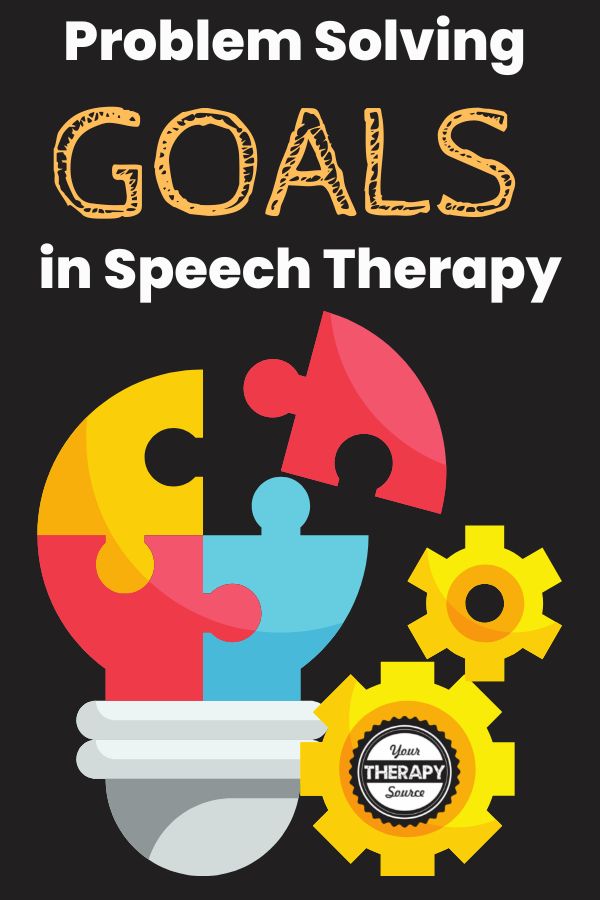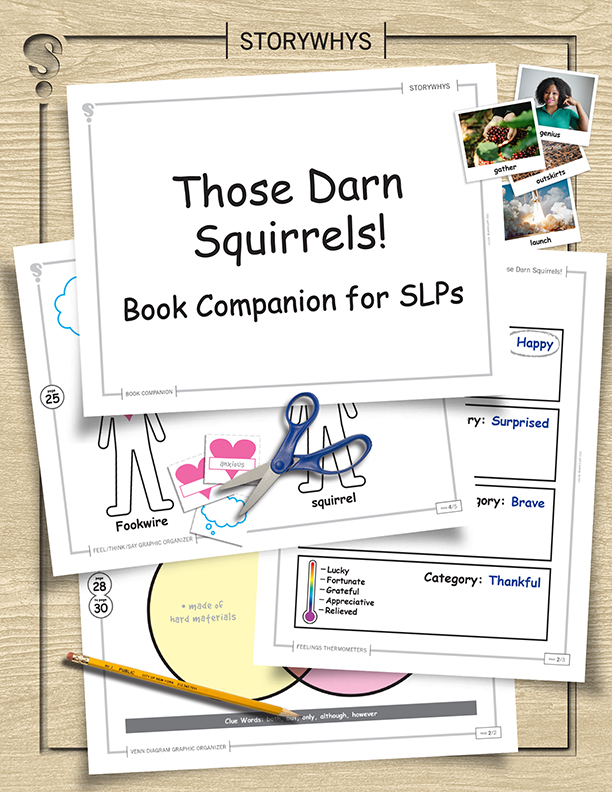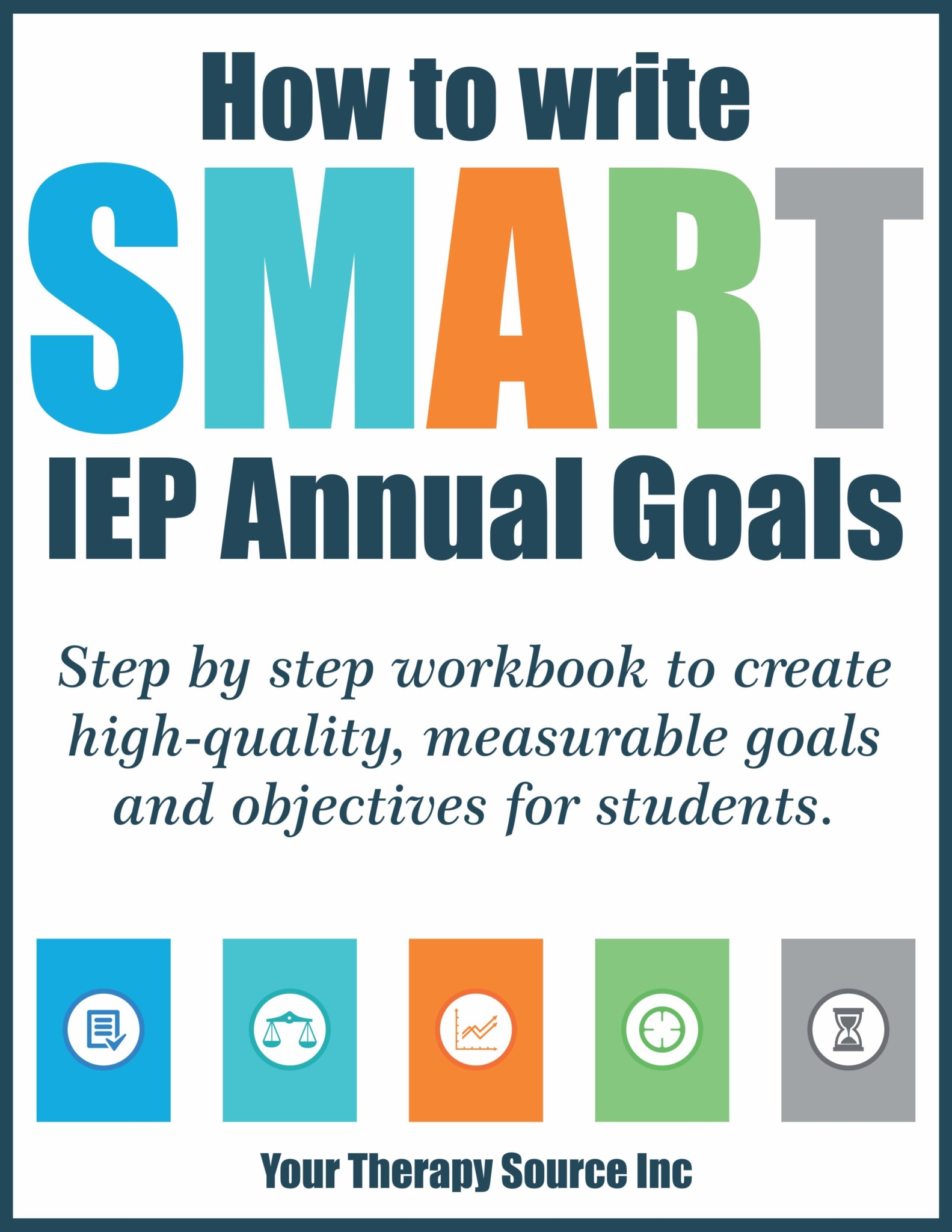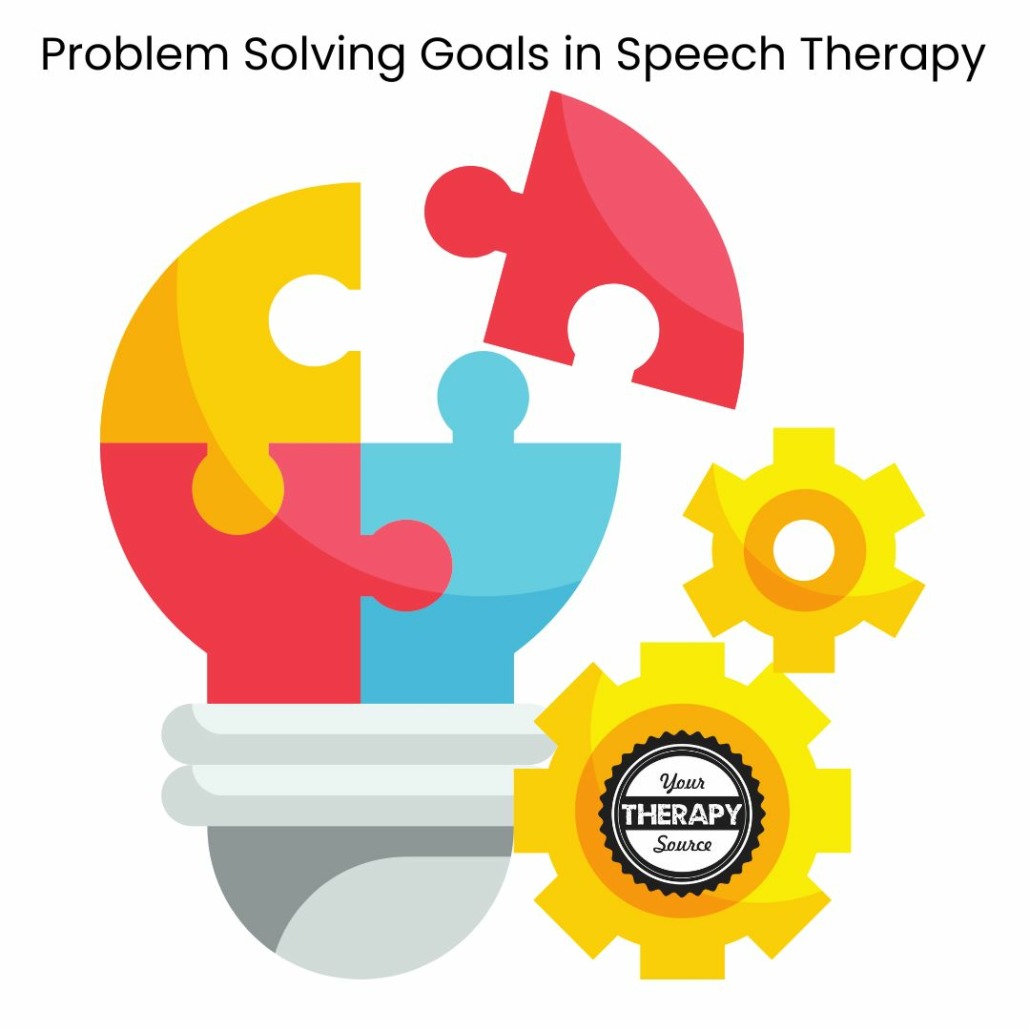

Your cart is currently empty.
Total: $0.00
Social & Pragmatic Language Goal Bank
- (client) will label emotions/feelings in communication partners or in pictures with 80% accuracy for 3 data collections.
- (client) will use words to express their feelings independently for 80% of opportunities across 3 data sessions.
- (client) will state a logical answer to what another person might be feeling based on a social situation with 80% accuracy for 3 data collections.
- (client) will answer pragmatic questions about social situations during structured activities with 80% accuracy for 3 data collections.
- (client) will identify a problem in a social setting/picture scene with 80% accuracy for 3 data collections.
- (client) will present a solution to a problem independently with 80% accuracy for 3 data collections.
- (client) will label a problem size (small, medium, big) after identifying a problem with 80% accuracy across 5 data collections.
- (client) will make inferences after hearing part of a story/social situation with 80% accuracy for 3 data collections.
- (client) will name a flexible thinking strategy after hearing a problem scenario/social situation in 80% of opportunities across 5 data collections.
- (client) will predict what happens next after hearing part of a story/social situation with 80% accuracy across 5 data collections.
- (client) will identify appropriate/inappropriate behaviors in a story/social situation with 80% accuracy for 3 data collections.
- (client) will describe why a behavior is appropriate/inappropriate in a story/social situation in 80% of opportunities for 3 data collections.
- (client) will use greetings and farewells by looking and verbalizing or by waving "hi"/"goodbye" for 5 consecutive sessions.
- (client) will use appropriate eye contact during a conversational exchange for 5 consecutive sessions.
- (client) orient his eyes toward a speaker/activity after 1 verbal prompt in 80% of opportunities across 3 data collections.
- (client) will look toward a speaker when their name is called in 80% of opportunities for 3 data collections.
- (client) will maintain appropriate body orientation during a single activity for 3 activities per session for 3 data collections.
- (client) will request help independently in 80% of opportunities across 5 data collections.
- (client) will attend to self-directed activity for at least 1 minute without abandoning or transitioning activities across 5 data collections.
- (client) will attend to adult directed activity for at least 1 minute without abandoning activity across 5 data collections.
- (client) will maintain conversation for 3 turns by asking a questions or commenting with no more than 1 verbal prompt for 3 data collections.
- (client) will add an appropriate comment to a topic generated by a communication partner without prompting at least 10x across 3 data collections.
- (client) will ask an appropriate question about topic generated by a communication partner at least 10x across 3 data collections.
- (client) will participate in turn-taking with the therapist for 5 turns per opportunity with a minimum of 5 opportunities across 3 data collections.
- (client) will identify signs of listener boredom or disinterest independently with 80% accuracy for 3 data collections.
- (client) will use age-appropriate vocal characteristics (intonation, volume) for 80% of conversational turns during therapy sessions independently for 3 data collections.
Made with love in Austin, Texas
© 2020 Shine Speech Activities
Product Added To Your Cart
There are 0 Items In Your Cart
Total Price: $0.00
Compare Product

Problem Solving Goals Speech Therapy

All children are required to solve-problems throughout their school day. Most curricula, be it the Common Core State Standards (CCSS), or various social emotional learning programs, require students to solve problems. Social communication skills also rely heavily on children’s ability to recognize and solve problems. This is why some students have problem solving goals for speech therapy or in the classroom.
Of course, problem-solving looks different at different levels of development, but opportunities to solve problems are embedded all throughout the school day, from preschool to high school.

Those Darn Squirrels Book Companion for Speech-Language Pathologists
Problem solving – levels of development.
Preschoolers are expected to follow routines, navigate materials, practice turn-taking, self-advocate, share with peers, and manage unexpected changes and feelings. Elementary school students are expected to practice perspective-taking by reading the facial expressions and body language of their peers in order to find kind solutions to problems that may arise with classmates, and to use context clues to infer the meaning of unfamiliar vocabulary to independently support their own reading comprehension. Middle and high school students are expected to identify and describe problems outlined in their reading assignments, solve complex mathematical problems, and comprehend increasingly sophisticated social interactions.
These skills are all forms of problem-solving, and they all have underpinnings in speech, language, and executive functioning – all areas speech therapists are specialized in supporting.

HOW TO WRITE GOALS FOR SPEECH THERAPY
As school-based speech-language pathologists (SLPs), we are ideally positioned to help children with their problem-solving abilities, given that many problem-solving skills are language-based, and because our therapy sessions allow us to teach our students in a small group setting with a small number of peers, or even one-on-one.
Before we dive into writing Individualized Education Program (IEP) goals that are specific to problem-solving, let’s get a quick refresher on best practices when writing speech and language goals in general.
The speech therapy IEP goals we write for our students should target the speech or language challenges they having that are preventing them from reaching the grade-level benchmarks and expectations in their classroom curriculum. The goals we choose should be informed by a good-quality speech and language assessment, which will identify both the specific difficulties a child is having with respect to their speech and language, as well as the ways in which these deficits are manifesting in the classroom.
Once we have developed a good understanding of a student’s speech and language weaknesses, and how this is impacting their academic and social success, we are ready to generate IEP goals for speech and language therapy.
While it can be tempting to recycle IEP goals from other students with similar needs, or to use a goal bank to generate goals, we should be using these sources as a starting point at most when writing long-term goals (and short-term objectives, if applicable); remember that the “I” in IEP stands for “individualized.” Every child is unique, with their own strengths, weaknesses, and personality; and the goals we write for them should reflect this.
The IEP goals we write should be SMART: specific, measurable, attainable, relevant, and time-bound. Let’s quickly go through what each of these qualifiers mean.
- Specific means that the skill should be observable, and measurable. It should be described using teacher- and parent-friendly language. We can also include any stimuli we’ll provide (prompts, verbal cues, and visual cues) with examples as needed.
- Measurable means we need to outline the criteria and conditions under which we’ll measure the child’s performance. This can include accuracy levels (e.g., percentages, number of trials, the number of consecutive sessions the student will demonstrate the skills), and under what conditions we should measure the child’s ability to demonstrate this skill. For example, if a child is learning how to use a strategy to manage annoying peers that involves going through a set of steps, do we expect them to demonstrate this skill in a busy classroom, or in the context of a quieter therapy room with two other peers?
- Attainable means that we can reasonably expect the child to achieve this goal within the allotted timeframe, based on our clinical judgement, knowledge of developmental norms, and input from other members of the child’s team.
- Relevant means that the goal should be related to supporting the student with a skill they need in order to be more successful in the classroom setting. This can be a skill found in the CCSS or other curricula, or any skill that is part of the expectations for that student in the classroom. Our goal should be a speech or language-based component of a larger skill, and can be a building block towards a more complex skill. Goals can also target a child’s ability to use a compensatory strategy if there is a reason they can’t demonstrate a particular skill in the classroom.
- Time-bound means that we expect the child to reach the goal within 12 months, when the IEP has to be renewed.

How to Write IEP Goals Workbook
Examples of problem solving goals for speech therapy.
Now that we know that SLPs can help to support children with the language- and executive functioning-based underpinnings of problem-solving, and we know how to write SMART IEP goals, let’s look at a few examples.
Liam is a preschooler with expressive language delays. Because of his expressive language challenges, he is not making requests in the classroom to get his basic needs met, such as asking for help putting his shoes on after nap time or asking teacher to open containers like his milk at lunch. Liam gets frustrated and cries often. His teachers would like him to problem-solve by asking for help in times like this. Here is a potential goal we could write for Liam:
“Within one year, Liam will ask for help/desired items using short phrases (e.g., “help me please”, “can I have (item)”, “open please”) in the classroom setting with faded models in 3 out of 4 observed opportunities, over three consecutive school days, as measured by the speech therapist and/or classroom teacher.”
Maya is a third-grader with pragmatic language and executive functioning challenges. She is having a difficult time problem-solving and managing her reactions when she perceives other children in her class to be annoying her. Because of this, Maya is often having big reactions, including aggression, in the classroom where her teacher needs to co-regulate her 1:1, which is taking away from instruction time for the other students and is negatively impacting Maya’s social interactions and friendships with her classmates. Here is a potential goal we could write for Maya:
“By the end of the school year, Maya will correctly use a 5-step strategy (ignore, move away, ask nicely, ask firmly, get a teacher to help) to manage her classmates’ behaviors she finds distracting or annoying independently during role playing scenarios in the therapy room with one to two other peers in 4 out of 5 trials over 5 consecutive sessions, as measured by the speech therapist.”
Malcolm is a sixth-grader who has a language disorder which is impacting a variety of skills, including his reading comprehension. His teacher reported that Malcolm has particular difficulty responding to comprehension questions when there are idioms and metaphors in the text, and he does not know how to use strategies when he encounters this type of language. A comprehensive language assessment confirmed that Malcolm has difficulty comprehending figurative language. Here is a potential goal we could write for Malcolm:
“In one year, Malcom will use context clues in reading passages to choose the correct meaning of 30 previously unfamiliar idioms and 30 previously unfamiliar metaphors, each from a field of 5 multiple choice answers with a minimum of 90% accuracy as measured by the speech therapist.
Remember that your speech therapy goals will look different, based on the specific needs and profile of your student!
CONCLUSION ON PROBLEM SOLVING SPEECH THERAPY GOALS
Problem-solving is an important skill to help children develop, and speech therapists play a key role in helping them achieve their goals. From preschoolers learning how to ask for help when needed, to third graders managing social interactions with peers and sixth graders comprehending complex language structures – problem-solving can be applied across all ages. With the right SMART IEP goal writing strategy and techniques from cognitive neuroscience principles, SLPs are well-equipped to support students of any age to reach their fullest potential. It’s up to us as practitioners to ensure that we provide our clients with the best possible care so they can continue on their road toward success!
The Problem Solving Speech Therapy Goals article was written by Jane Clapp, MA, CCC-SLP. She has worked as a pediatric speech-language pathologist in New York City schools for over 20 years. She is the creator of StoryWhys book companions, which help SLPs provide high-quality, literature-based language therapy with elementary aged students. You can find resources, ideas, and information for busy SLPs on her blog, StoryWhys.com
RELATED POSTS
Social Pragmatics Goals Speech Therapy
List of Strengths and Weaknesses for IEPs
Written Expression IEP Goals
Daily Living Skills – Goals and Objectives
Social Emotional IEP Goals
Behavior IEP Goals
Self Regulation IEP Goals
Executive Function IEP Goals
Fine Motor IEP Goals

Your Therapy Source
Email: [email protected] Phone: (800) 507-4958 Fax: (518) 308-0290


IMAGES
VIDEO
COMMENTS
If you’re on the hunt for a long-term goal for problem solving here is our list of goals to add to your goal bank. 1. Given a problem and problem solving graphic organizer, STUDENT will identify 3 soluti…
-Problem Solving. Given a problem and problem solving graphic organizer, STUDENT will identify 3 solutions, the 3 consequences of those solutions, then determine the …
Your Goal Bank for Adult Speech Therapy comes with 150+ ready-made goals. Click for aphasia goals, dysarthria goals, memory goals, AAC goals—and much more.
Goal Bank — The Speech Express. Vocabulary. Mix and match the following skills, supports, and materials below to create an individualized IEP goal for vocabulary. Formula: Given [materials] and [supports], NAME will [vocabulary …
Speech therapy goal bank for social and pragmatic language, including dozens of goals to improve communication.
Problem-solving is an important skill to help children develop, and speech therapists play a key role in helping them achieve their goals. From preschoolers learning how to ask for help when needed, to third graders …
Collaborating with IEP teams, including speech-language pathologists and educators, is key to identifying and targeting specific pragmatic language skills. Strategies such as explicit instruction, visual supports, role-playing, and peer …
Discover effective strategies for setting and achieving language therapy goals across age groups. Improve speech and communication skills with SMART objectives.